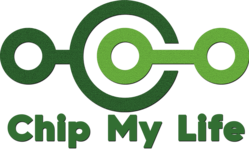Q: What’s the difference between RFID and NFC?
A: RFID is a generic name for a range of technologies that allow you to identify objects using radio waves (RF). This means just about anything that communicates wirelessly can be considered “RFID”, including your cell phone which has several radio transceivers which all have unique identifiers (MAC addresses, IEMI, etc.). Typically though, when someone talks about “RFID tags”, they are generally referring to passive (unpowered) tags, which can range in operating frequency, memory capacity, and features.
NFC is a standard created by Nokia, Sony, and Philips. They created the NFC Forum and the forum decides on NFC standards. Those NFC standards are made up of two basic parts, passive RFID tags (NFC tags) and active device communication (peer to peer). The NFC standard defines 4 different types of passive RFID tags which can be used as NFC tags, based on their memory structure and communication protocols (frequency, encoding, etc.). So, all 4 types of “NFC tags” are just RFID tags that have been chosen by the NFC forum.
For example, a Mifare Ultralight tag is a passive RFID tag that operates at 13.56mhz and communicates using ISO14443A. The Mifare Ultralight has a memory structure that can be formatted and used as an NFC Type 2 tag. However, the Mifare S50 1K tag is also a passive RFID tag that operates at 13.56mhz and is also ISO14443A, but it is not NFC compliant. The memory structure used by the Mifare “classic” S50 1k tag is not compliant with the NFC standard, so it is not considered an “NFC tag”, even though it is sold as an “NFC tag” by many vendors who lying to people in order to capitalize on NFC buzz. Don’t believe the hype.
Q: What’s the difference between implantable transponder types?
A: We sell 2 different types of x-series implantable glass transponders (tags), including the xEM, xNT. The xEM and xNT are sold in kit form and are preloaded into injector assemblies, and thus are sold under the xEMi and xNTi SKUs.
xEM 125khz EM4102
The xEM is a low frequency 125khz transponder based on the EM4102 chip which has no user programmable memory or security features. Each xEM tag is programmed at the factory with a unique ID that cannot be changed, and it works with common EM41xx based readers available through many hobby electronics shops and electronics outlets. Several commercial systems can also read and work with the xEM tag, however we offer it as a “starter” implant for people new to RFID in general. The xEM is low cost, simple to use, and we also sell an xEM Access Control unit that works beautifully with the xEM tag that enables hobbyists to cheaply and easily build simple access control type projects.
xNT 13.56mhz NTAG216
The xNT is a high frequency 13.56mhz transponder based on the NTAG216 chip. The NTAG216 has 888 bytes of user programmable memory, 32 bit password protection security features, and is both ISO14443A and NFC Type 2 compliant. You can use the xNT with both commercial systems that work with ISO14443A as well as NFC devices like mobile phones and new ISO14443A and NFC hobby electronics as well. There are several hobby electronics readers and reader kits available, including one we sell, that work with Arduino and other micro-controllers commonly used by hobbyists and product engineers alike.
RFID Keys
There is a common misunderstanding that somehow a “key” is programmed on to the RFID tag and in order to get access to multiple doors or systems you need to program multiple keys on to the tag. This kind of thinking is natural because that’s how typical metal door keys work, but it is normally incorrect (some RFID systems do work this way but it’s very rare). Each tag has a unique ID (called a UID), and these IDs are programmed into the doors and systems, not the other way around… so if you want 1000 people to get through door A, you have 1000 tag IDs programmed into door A’s RFID reader. If someone loses their tag (UID 3718), they remove tag 3718 from the list and that’s that. This approach means you can use one RFID tag with multiple doors and systems.
Cloning vs Emulation
Emulating means you are using a piece of active circuitry to pretend to be a tag. This basically means spoofing a reader into thinking it’s talking to the spoofed tag instead of a circuit board designed to pretend to be a tag. Cloning means you copy one tag’s UID and memory contents from one “source” tag to another “target tag” so it matches exactly. Typical tags sold by reputable companies come with the UID bits programmed by the factory and locked so they cannot be changed. This is what ensures they are unique. There are standards built on the fact that UID bits are not supposed to be changeable, meaning the manufacturers are able to keep control of the UID sequence to try to ensure uniqueness of the tags they produce. However, some chip makers have created chips that don’t play by these rules, and the chips allow you to change the UID bits at will.
If you are unable to clone a tag ID to your implant, the best way to approach using your implant with school and work access control systems is to buddy up with the IT department or whoever is in charge of managing the access control systems at your work or school. Show off your implant and get them interested in seeing if it will work with the system there. Then broach the idea of trading in your access card in favor of simply adding your implant’s UID to the system.
Token, Travel and Payment Systems
Now let’s talk about transit and laundry cards (token systems). Typically these systems use their own method of leveraging memory blocks and access keys (Mifare Classic and DESFire access keys), meaning even if you could get your implant added to their system, it would require formatting your tag and setting up access keys in such a way that it would become totally dedicated to that purpose. You could no longer access memory blocks on your own tag or use it for any other purpose. This might be ok for some of you, but for many I could see that as being a problem.
Now, payment systems like bank cards and credit cards. This one is really tricky because there are multiple technologies out there and they are all currently based on chips with memory structures specifically designed to make it difficult to get at the payment information stored on the card. In short, they are designed to make attempts at copying the RFID functionality to another tag difficult or impossible. Some of you may have seen articles about how easy it is to pull payment data from RFID payment cards, and these articles are telling half-truths. The reason it’s easy is that the point-of-sale reader is doing the decoding work and just spitting out the payment data, but nobody has shown how it’s possible to actually decode or emulate the RF interface of one of these cards.
Some people consider removing chips and antenna coils from existing transit and payment cards and implanting those, and in some cases that has occurred… but in the case of payment cards, I would not want to have to remove and replace the implant every couple years when the payment data expires. Transit systems aren’t exempt from technology transitions either. Several transit systems from the Oyster system in London to my own Orca card system here in Seattle have phased out specific chip types in favor of others, sometimes multiple times. The temporary and transient nature of these systems precludes me from ever wanting to implant one of their chips into my body. There may be another solution to this problem however, so keep an eye on our Facebook page.

